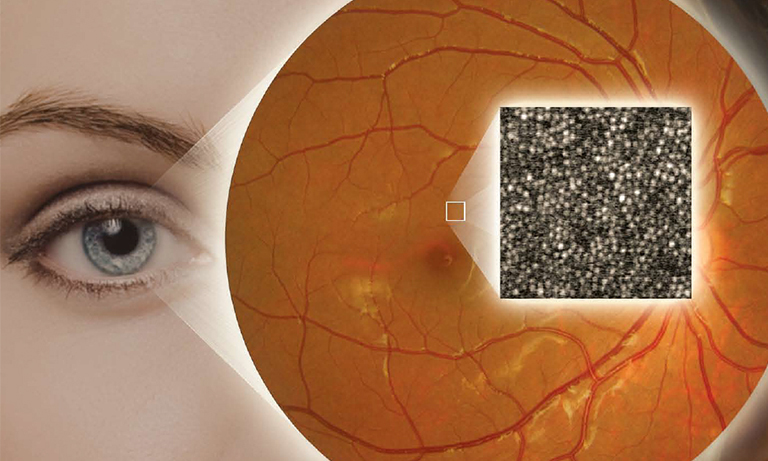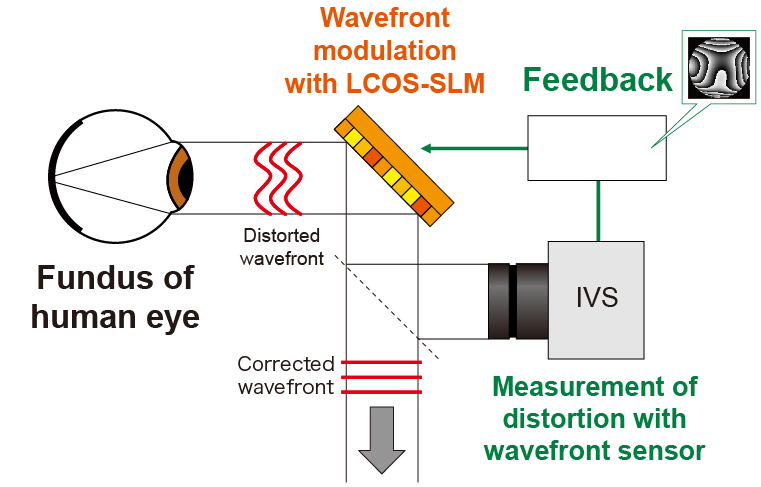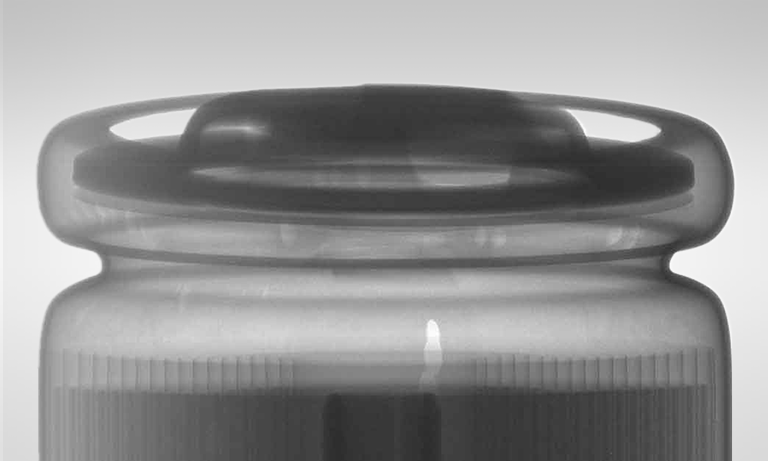United Kingdom (EN)
Select your region or country.
Adaptive optics technology and high-resolution retina imaging
Adaptive Optics (AO) is a technology that directly improves the image quality obtained by measuring wavefront aberrations involved in the observation target and inside the optical instrument with a wavefront sensor and correcting it dynamically. This correction usually adapts a deformable mirror that directly changes the optical path length. However, in order to correct the aberrations with higher precision, we are researching technology using a phase modulator (LCOS-SLM) which able to shift the phase of the light wave locally and finely by changing the refractive index of liquid crystal materials. The current major application of adaptive optics technology is in the field of fundus imaging, where high-resolution images of the human retina can be obtained and thus the early diagnosis of eye diseases is highly expected.

By applying adaptive optics technology using LCOS-SLM to retina observation, it is possible to measure the retina with a spatial resolution of several microns (so that the photoreceptor cells can be seen). Figure 1 shows an overview of an adaptive optics retina imaging system. The human eye is irradiated with very weak light that sufficiently satisfies the laser safety standards, and the light scattered from the retina returns to the wavefront sensor via LCOS-SLM. The wavefront sensor consists of a microlens array and a highly sensitive vision camera. This wavefront sensor measures wavefront distortion caused by eye optics and imaging equipment. The negative feedback controller controls the input signal to the LCOS-SLM based on the wavefront distortion measured by the wavefront sensor so that the output wavefront becomes a plane wave (or a spherical wave with the desired curvature).

Figure 1: Principle of wavefront correction with adaptive optics
Results
Figure 2 shows examples of human retina images demonstrating the effect of aberration correction. Without aberration correction, only a blurred and noise image was obtained (Left: Without AO Correction). This will not provide useful information for observation. However, when aberration correction is activated, the photoreceptor cells (bright spots) become resolvable (Right: With AO Correction). The smallest photoreceptor cells in the human eye are only 2 µm to 3 µm; the result indicates that adaptive optics is essential to observe photoreceptor cells.

Figure 2: Results
The retina is known to have a multilayer structure. By using LCOS-SLM to control the focus position, it is possible to visualize the tissue of each layer of the retina. Figure 3 shows examples of retinal images obtained by controlling the focal depth position to the photoreceptor cell, blood vessel and nerve fiber layers. The left image shows the distribution of photoreceptors, wherein the bright spots are photoreceptor cells. From the photoreceptors image, it is possible to detect retinal abnormalities by analyzing the distribution density, cells arrangement, the presence or absence of defects, etc. The image of the blood vessel and blood cell in the middle shows a bifurcated blood vessel, and the blood vessel wall (the black line) and the blood cell in the blood vessel (the bright area between the two black lines). Blood flow can also be measured by video recording. In the image of the nerve fiber on the right side, the bundles of nerve fibers extending from the upper left to the lower right can be seen. The development of advanced medical technology is expected by analyzing the observed high-resolution fundus images.

Figure 3:Imaging results when focus on different depth position.
Observation by focus adjustment with controlling the LCOS-SLM
Publications
- H. Huang, T. Inoue and H. Tanaka, “Stabilized high-accuracy correlation of ocular aberrations with liquid crystal on silicon spatial light modulator in adaptive optics retinal imaging system,” Optics Express 19(16), 15026-15040 (2011).
- H. Huang, T. Inoue, H. Toyota, and H. Tsutomu, “Long-term stable and high performance adaptive optics system using liquid crystal on silicon spatial light modulator for high resolution retinal imaging,” Proc. SPIE, 8200, 820002(2011).
- H. Huang, et. al., “Adaptive optics scanning laser ophthalmoscope using liquid crystal on silicon spatial light modulator: Performance study with involuntary eye movement,” Japanese Journal of Applied Physics, 56(9S), 09NB02(2017).
- Confirmation
-
It looks like you're in the . If this is not your location, please select the correct region or country below.
You're headed to Hamamatsu Photonics website for GB (English). If you want to view an other country's site, the optimized information will be provided by selecting options below.
In order to use this website comfortably, we use cookies. For cookie details please see our cookie policy.
- Cookie Policy
-
This website or its third-party tools use cookies, which are necessary to its functioning and required to achieve the purposes illustrated in this cookie policy. By closing the cookie warning banner, scrolling the page, clicking a link or continuing to browse otherwise, you agree to the use of cookies.
Hamamatsu uses cookies in order to enhance your experience on our website and ensure that our website functions.
You can visit this page at any time to learn more about cookies, get the most up to date information on how we use cookies and manage your cookie settings. We will not use cookies for any purpose other than the ones stated, but please note that we reserve the right to update our cookies.
1. What are cookies?
For modern websites to work according to visitor’s expectations, they need to collect certain basic information about visitors. To do this, a site will create small text files which are placed on visitor’s devices (computer or mobile) - these files are known as cookies when you access a website. Cookies are used in order to make websites function and work efficiently. Cookies are uniquely assigned to each visitor and can only be read by a web server in the domain that issued the cookie to the visitor. Cookies cannot be used to run programs or deliver viruses to a visitor’s device.
Cookies do various jobs which make the visitor’s experience of the internet much smoother and more interactive. For instance, cookies are used to remember the visitor’s preferences on sites they visit often, to remember language preference and to help navigate between pages more efficiently. Much, though not all, of the data collected is anonymous, though some of it is designed to detect browsing patterns and approximate geographical location to improve the visitor experience.
Certain type of cookies may require the data subject’s consent before storing them on the computer.
2. What are the different types of cookies?
This website uses two types of cookies:
- First party cookies. For our website, the first party cookies are controlled and maintained by Hamamatsu. No other parties have access to these cookies.
- Third party cookies. These cookies are implemented by organizations outside Hamamatsu. We do not have access to the data in these cookies, but we use these cookies to improve the overall website experience.
3. How do we use cookies?
This website uses cookies for following purposes:
- Certain cookies are necessary for our website to function. These are strictly necessary cookies and are required to enable website access, support navigation or provide relevant content. These cookies direct you to the correct region or country, and support security and ecommerce. Strictly necessary cookies also enforce your privacy preferences. Without these strictly necessary cookies, much of our website will not function.
- Analytics cookies are used to track website usage. This data enables us to improve our website usability, performance and website administration. In our analytics cookies, we do not store any personal identifying information.
- Functionality cookies. These are used to recognize you when you return to our website. This enables us to personalize our content for you, greet you by name and remember your preferences (for example, your choice of language or region).
- These cookies record your visit to our website, the pages you have visited and the links you have followed. We will use this information to make our website and the advertising displayed on it more relevant to your interests. We may also share this information with third parties for this purpose.
Cookies help us help you. Through the use of cookies, we learn what is important to our visitors and we develop and enhance website content and functionality to support your experience. Much of our website can be accessed if cookies are disabled, however certain website functions may not work. And, we believe your current and future visits will be enhanced if cookies are enabled.
4. Which cookies do we use?
There are two ways to manage cookie preferences.
- You can set your cookie preferences on your device or in your browser.
- You can set your cookie preferences at the website level.
If you don’t want to receive cookies, you can modify your browser so that it notifies you when cookies are sent to it or you can refuse cookies altogether. You can also delete cookies that have already been set.
If you wish to restrict or block web browser cookies which are set on your device then you can do this through your browser settings; the Help function within your browser should tell you how. Alternatively, you may wish to visit www.aboutcookies.org, which contains comprehensive information on how to do this on a wide variety of desktop browsers.
5. What are Internet tags and how do we use them with cookies?
Occasionally, we may use internet tags (also known as action tags, single-pixel GIFs, clear GIFs, invisible GIFs and 1-by-1 GIFs) at this site and may deploy these tags/cookies through a third-party advertising partner or a web analytical service partner which may be located and store the respective information (including your IP-address) in a foreign country. These tags/cookies are placed on both online advertisements that bring users to this site and on different pages of this site. We use this technology to measure the visitors' responses to our sites and the effectiveness of our advertising campaigns (including how many times a page is opened and which information is consulted) as well as to evaluate your use of this website. The third-party partner or the web analytical service partner may be able to collect data about visitors to our and other sites because of these internet tags/cookies, may compose reports regarding the website’s activity for us and may provide further services which are related to the use of the website and the internet. They may provide such information to other parties if there is a legal requirement that they do so, or if they hire the other parties to process information on their behalf.
If you would like more information about web tags and cookies associated with on-line advertising or to opt-out of third-party collection of this information, please visit the Network Advertising Initiative website http://www.networkadvertising.org.
6. Analytics and Advertisement Cookies
We use third-party cookies (such as Google Analytics) to track visitors on our website, to get reports about how visitors use the website and to inform, optimize and serve ads based on someone's past visits to our website.
You may opt-out of Google Analytics cookies by the websites provided by Google:
https://tools.google.com/dlpage/gaoptout?hl=en
As provided in this Privacy Policy (Article 5), you can learn more about opt-out cookies by the website provided by Network Advertising Initiative:
http://www.networkadvertising.org
We inform you that in such case you will not be able to wholly use all functions of our website.
Close


























































































































